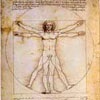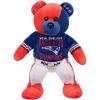Character Descriptions
Who is this person? And that person? Who are the characters populating this fictional world that I'm reading about? What do they look like, what are their personalities, and why should I care?
These are all questions that need to be asked and answered with every new story that you put out, as you are trying to paint a vivid picture with the words you type on the screen. No matter how clear the vision of your main characters and love interests may be in your head, you have to keep in mind the fact that your readers only have your descriptions to go on when it comes to visualizing the people they're reading about. If you're looking to set the stage for your written experience, then you're going to want to give your readers a series of images to adhere to. Someone that they can picture walking, talking, and acting, in your little movie of the mind. So, this week, we're talking about character descriptions. Their importance, their effect on readers, and how to effectively translate the actors in your story to an eager audience.
Let's get into it!
Whenever I read a story for the first time, I mentally try to set the scene and imagine the characters to the best of my ability. If you mention that someone has amazing blue eyes, I put that in the back of my mind and picture someone with amazingly blue eyes. If you mention that they're an older man with a 5 o'clock shadow, then I picture that. If you mention a certain hair style, like a Mohawk or an emo fringe or a buzzcut...then I keep that with me. This works to further connect me to the story that I'm reading. Many of your readers are doing the same thing. They want to breathe life into the characters that they're meeting for the first time. I always think about a story as a cooperative experience between writer and reader. You are both creating the dream at the same time. You set the bare bones, and they fill in the details. This can make for a really engrossing read and can make your story more realistic and enjoyable through the sheer involvement of your audience in its creation. I can break this process down into three rules that have helped me out in the past.
- 'Suggest'. Don't control. If you are giving a physical description of the characters in your story...leave your readers some room to create their own vision of what they look like. Always remember the eye of the beholder when it comes to beauty. Usually, when I give details on a character, they're very basic. Eye color, hair color, general build, skin color or ethnicity, approximate age, style of dress...etc. Sometimes, if I have something or someone in mind specifically, I'll add a few extra details that I think will complete the exact look that I'm going for. But, I feel that it's important to let your audience define their own vision of beauty. I'm willing to bet if I asked them what some of my characters look like in their mind's eye...no two visions would be alike. That's a GOOD thing! Allow them to fall in love with characters that they, personally, find super attractive. Let them attach the physical attributes of the ultimate love interest to something or someone that they hold close to their heart. It makes for a more immersive experience while reading.
- Only add descriptions that are necessary. As a personal rule, I never add certain details unless they're a part of the character himself or herself. If they fit into the scale of what is considered 'average', then I feel like those descriptions are readily assumed, and therefore not needed. But...if one of those details is a defining part of the character themselves, then I might make mention of it. As an example...if a character is your average 5' 7" tall, give or take...I won't make that a part of the story. However, if the character is extra tall? Then that is a trait that gives the character a unique 'extra' that should be a part of what's going on. This goes for other details that need to be known if it affects how that character is seen or how they act. If their overweight, or emaciated, or rippling with muscles, or very short for their age. If they have a disability or a visible scar...if they have freckles, or braces, or wear glasses...these are all things that might not be assumed by your readers unless you tell them directly that this is what they look like. So, unless their appearance includes features that are somewhat unique to them...leave them out. You don't have to mention height, weight, or anything of that sort if they're average or not a departure from your typical protagonist's appearance.
- Let the character speak for themselves, it will show the reader who they are through their actions. Basically, this means that you don't have to 'tell' your readers who this character is through exposition or by using stereotypes to define who they are in relation to the rest of your story. When I started writing these stories, I felt the need to mention that the main character was gay. But that wasn't necessary. The main character is a boy, and he finds another boy attractive. That already explains the 'gay' issue without me having to announce it. That's a bit of fat that can be trimmed off of the story when I'm putting it together. I have written stories with characters who were blind, or deaf, or transgendered, and those details were needed to set up that particular character and initiate the kind of interactions that they were going to have with other characters in the story. But if I can describe them and their differences without actually saying it out loud...then it will work much better in the long run. This goes back to my article on 'show, don't tell'. Sometimes your characters can provide all the details needed through their actions and deeds, without the desperate need for you to spell it out for your audience. They'll get it. Just write the character with those traits in mind, and people will make their own assumptions along the way. Some details are self explanatory when it comes to the flow and direction of the narrative. So let it stand on it's own. K?
So, keep those three rules in mind, and you can create a character that you love and want to present to your audience, while simultaneously giving your readers an opportunity to personalize their own visions of beauty and attraction by filling in the details of the characters you've given them to work with. Everybody has an idea of the most beautiful person in the world! Let them make that the love interest in your story, and they'll follow you, chapter to chapter, until the very end. Participation in the creation of a good story is key to making it work. There's a give and take between reader and writer. Never forget that.
I hope this helps you guys get an even deeper understanding of your audience, and vice versa. Good luck to you all! And I'll talk to ya some more next weekend!
-
 6
6
-
 4
4








5 Comments
Recommended Comments
Create an account or sign in to comment
You need to be a member in order to leave a comment
Create an account
Sign up for a new account in our community. It's easy!
Register a new accountSign in
Already have an account? Sign in here.
Sign In Now